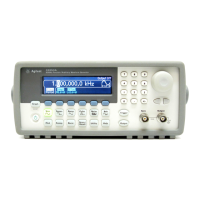312
Chapter 7 Tutorial
Frequency Sweep
7
Frequency-Shift Keying (FSK) FSK is similar to FM except the
frequency alternates between two preset values. The rate at which the
output shifts between the two frequencies (called the “carrier frequency”
and the “hop frequency”) is determined by the internal rate generator or
the signal level on the rear-panel Trig In connector. Frequency changes
are instantaneous and phase-continuous.
The internal modulating signal is a square waveform with 50% duty cycle
.
You can set the
internal FSK rate from 2 mHz to 100 kHz.
Frequency-Shift Keying
Frequency Sweep
Frequency sweeping is similar to FM but no modulating waveform is use
d.
Instead, the internal DSP sets the output frequency based on either a
linear or logarithmic function. In a linear sweep, the output frequency
changes in a constant “hertz per second” manner. In a
logarithmic
sweep
,
the output frequency changes in a constant “octaves per second” or
“decades per second” manner. Logarithmic sweeps are useful for covering
wide frequency ranges where resolution at low frequencies would
potentially be lost in a linear sweep.
You can generate a sweep using an internal trigger source or an
external hardware trigger source. When the internal source is selected,
the function generator outputs a continuous sweep at a rate determined
by the sweep time specified. When the external source is selected,
the function generator will accept a hardware trigger applied to the rear-
panel Trig In connector. The function generator initiates one sweep each
time Trig In receives a TTL pulse.
Modulating Signal
Modulated Carrier

